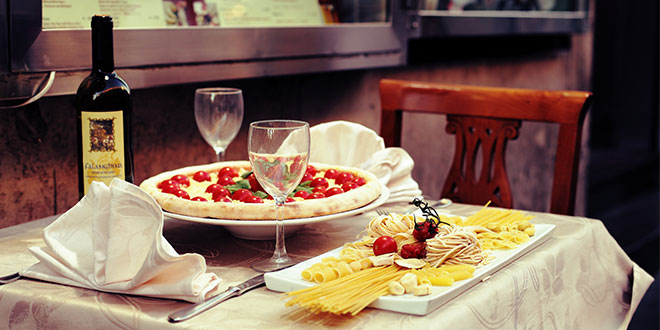Last Updated on March 22, 2023
Italy has a renowned reputation for its expertise in food and beverage, from their myriad of freshly made pasta, to being in the elite crest of wine-producing countries, Italy’s indulgent cuisine is something you cannot pass up! But if you’re traveling to Italy for the first time, there may be some restaurant customs that tourists aren’t used to. These tips will equip travelers and take some of the shock out of culture shock.
Your dish is a work of art
When being seated, you will notice the lack of salt, pepper, and sugar packets, or any other flavor enhancers on the table. After the chef makes the meal to order, he designs it in a way that is meant to be eaten as is, not tampered with. The plating, the garnish, the texture, and colors fuse together to create an authentic Italian masterpiece. Feel free to take an Instagram photo!
Eating in foreign countries often makes people hesitant and want to stay within their comfort zone. Travelers should practice the habit of taking two bites of the food first, if skeptical, then decide if they want to continue eating it or not. To simply refuse food right off the bat confines people and limits them in fully experiencing a new culture. In Italy, everything on the plate was put there with a purpose, so give it a try!
Pour it up
Wine is as common to drink with a meal in Italy, as Americans order a Coke with their pizza. Italians grow up with drinking wine on a regular basis, instead of having it reserved for special occasions such as dinner parties and fancy celebrations like we do in the U.S. There is a stigma that comes with people in the U.S. abusing alcohol. American youths have the stereotype of being “crazy party-goers” to other countries. The drinking age there is 18, whereas the few years difference between that and 21 build up anxious tension that leads to American teenagers going overboard with drinking. At any rate, Italian wines will be of the highest quality in the world, whether it be a white, red or rosé- due to Italy’s climate conditions.
You will be asked if you would like water or wine to start. If you choose water, you have the option of sparkling or non-sparkling, and will receive it in a bottle, not in a glass with ice.
Let us break bread together
Bread is the best way to appease a growling stomach. Italy’s bread is often made fresh by hand each morning. Americans are accustomed to warm bread so they can slather butter on it to melt, however many restaurants in Italy will leave their bread basket cold. Be sure to let the waiter know if you would like to keep the bread on the table- if not, you may get charged extra for it! Instead of butter, there will be a small dish of olive oil to dip the bread in, just like the ancient Romans did. You might find it to be rather bland-tasting because Italians do not use salt or other preservatives in their bread.
‘To-Go’ is a No-Go
When traveling to Italy, make sure to bring a full appetite!
TAKEAWAY: Guests are expected to finish all of their meal in the restaurant. Asking for a doggy bag is considered an insult to the chef. The meal was prepared for you to enjoy in the moment, not to be packed up in a plastic container. They believe that reheating a dish ruins the consistency, flavor and overall experience.
In the U.S. three-course meals are the standard with an appetizer, main course and the sweet ending of dessert. But expect much more than that with a traditional Italian meal. Begin with an apertivo, which may be a small dish of olives, nuts or cheeses. Then you’ll have antipasti, consisting of a platter of salami or prosciutto. Then we get to primi, which means the first course of hot food; it is usually a kind of pasta. Followed by secondi, the meat or seafood dish, served with contorni, the vegetables. You might be served a plate of fruits and cheeses in between here and the home stretch to dessert. Coffee or espresso is served only after the meal is concluded; not with dessert like in America because coffee deadens the taste buds and prevents your tongue from experiencing the food.
As you can see these types of meals take time, therefore, there are rarely fast food places, especially in rural Italian cities. In fact, this way of eating is part of the slow food movement. The American “in-and-out- in-thirty minutes-or-less” mentality does not translate here. Italian culture wants you to sit and enjoy your meal and your company for hours.
Beware of Traps
Some restaurants in high-tourist cities like Rome or Venice will take advantage of the hundreds of awe-struck visitors who are weary and hungry from sightseeing. They may have waiters or hostesses flag down guests and entice them to come in. Their music might be playing much louder or have flashy sandwich boards listing today’s specials to garner the attention of passersby. If you show interest at first then start to walk away, the staff will hastily try to convince you to stay (here, the “take your time while you dine” attitude doesn’t apply!)
Take a look at the menu if you can get your hands on one before being seated. Images of the food are a negative sign. There is no need to show a what fettuccine alfredo looks like to a customer in Italy. (True, authentic Italian restaurants will not do this.) In an attempt to appeal to the American customer, multiple pictures of menu items indicate a restaurants’ sub-par quality.
This guide can vary depending on where you go in Italy, but for the most part these are the unspoken rules of the road! To decide where you can go first, you can check the “7 Must-Visit Italian Food Destinations“.
 Travel for Food Hub The Food Blog for Travel Lovers
Travel for Food Hub The Food Blog for Travel Lovers
















